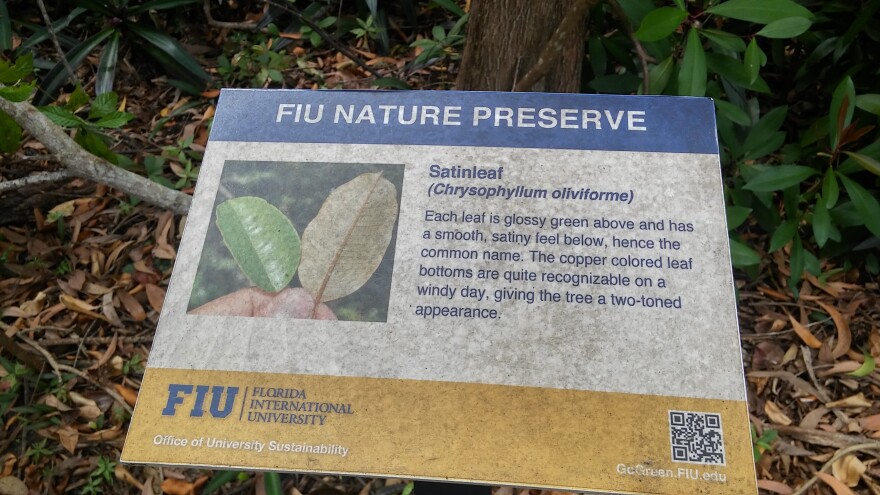Florida International University is in the process making two new sports fields on its Sweetwater campus, and many students and staff are angry that the location will pave over part of a nature preserve.
Joshua Muñoz-Jiménez has been tilling, planting and pulling hard to find fruits and vegetables in an organic garden he manages for FIU. He’s a third-year student majoring in agricultural sciences.
The garden is on the boundary of an 11-acre nature preserve on campus.
“We have tomatoes with hair on them,” says Muñoz-Jiménez, “we have tomatoes that have two little legs on them, we have long purple eggplant, we have one that looks like a baseball…”
FIU’s Board of Trustees recently voted unanimously to build the athletic fields on three acres of the nature preserve.
Supporters of the plan say the sports fields are sorely needed because the student body is getting bigger -- and more students are playing intramural sports.
But there’s a lot of opposition.
Muñoz-Jiménez gathered over 8,000 signatures from students and staff in a petition opposing the plan.
He worries about the fertilizer runoff from the fields affecting the produce from his garden. That produce is sold at farmer’s markets throughout Miami.
The site’s only water source is a man-made pond that will be filled in to make way for the fields.
“There’s definitely fish in there,” says Muñoz-Jiménez, “there’s heron on the sides, egrets, a lot of turtles use this area as well. I mean all kinds of life. You’ve got opossums, raccoons, foxes. This is their water source so once you destroy this, what happens?
According to FIU, the preserve is home to almost 450 plant and animal species -- some that are threatened or endangered.
FIU was built over the former Tamiami airport and includes three different ecosystems: tropical hardwood hammock, wetlands and the endangered pine rockland.
(Both plant and animal inventories can be found on FIU’s gogreen.fiu.edu website.)
The preserve in Sweetwater is also a living laboratory to more than 30 classes, where FIU professors teach subjects from biology to art.
Ken Jessell, the school's Chief Financial Officer, pushed the plan forward for the sports fields on the northern end of the preserve. He promises that more natural acreage and wetlands will be cultivated on the preserve’s south end.
“We’re the smallest campus in the State University system,” says Jessell, “and we don’t have a lot of land.”
The FIU Sweetwater campus only has one intramural field, and that, says Jessell, forces students to compete for playing time.
Robert Frye directs the school’s recreation center -- and manages scheduling requests for the current field.
“Having a second field would allow us to finish the games earlier in the evenings,” says Frye, “not force them to play so late. Also, we have conflicts between intramural and club sport matches and practices so it would give us a lot more flexibility on scheduling.”
Jose Gonzalez, a senior who plays intramural soccer, says the wait time isn't that bad -- five to ten minutes tops.
"We do have a lot of students," he says, "but the amount of people who use the intramural fields isn't that considerable in my opinion - and I just feel that it's wrong to tear down part of the nature preserve."
The original plan was for the new fields to be built next to the stadium, across the street from the preserve.
But Jessell and others saw a safety issue, with students having to cross over busy Southwest 17th Street.
Still, a lot of people on campus don’t think the solution is to substitute old growth trees and plants with new land.
During a light rain with the sky rumbling on a recent weekday, Munoz and his friend Andrew Fuentes walk to a towering strangler fig tree -- one that will be cut down. There’s a handwritten message tacked to the tree.
“One of the students recently wrote “I’ll miss you on it,” says Fuentes. “That wasn’t there before so obviously there’s people with sentimental feelings for this tree. It provides a lot of shade, there’s a nice picnic table here. A student just came and began studying... so you can see that this space is utilized in many ways.”
As the rain stops, Munoz looks around at the patch of green among the school’s concrete structures.
“Now that the rain has passed,” says Muñoz-Jiménez, “all the birds are coming out at the same time - everything is alive… it smells like life. It smells like productivity. It’s so beautiful.”
The changes to the preserve are expected to start this summer.










